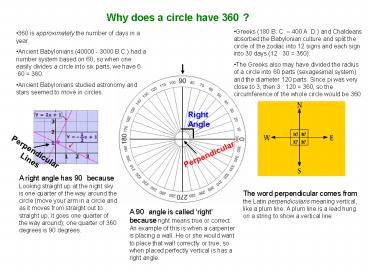Why does a circle have 360 PowerPoint PPT Presentation
Title: Why does a circle have 360
1
Why does a circle have 360?
- Greeks (180 B. C. 400 A. D.) and Chaldeans
absorbed the Babylonian culture and split the
circle of the zodiac into 12 signs and each sign
into 30 days (12 30 360). - The Greeks also may have divided the radius of a
circle into 60 parts (sexagesimal system) and the
diameter 120 parts. Since pi was very close to 3,
then 3 120 360, so the circumference of the
whole circle would be 360.
- 360 is approximately the number of days in a
year. - Ancient Babylonians (40000 - 3000 B.C.) had a
number system based on 60, so when one easily
divides a circle into six parts, we have 6 60
360. - Ancient Babylonians studied astronomy and stars
seemed to move in circles.
Right Angle
Perpendicular Lines
Perpendicular
A right angle has 90 because Looking straight up
at the night sky is one quarter of the way around
the circle (move your arm in a circle and as it
moves from straight out to straight up, it goes
one quarter of the way around) one quarter of
360 degrees is 90 degrees.
The word perpendicular comes from the Latin
perpendicularis meaning vertical, like a plum
line. A plum line is a lead hung on a string to
show a vertical line.
A 90 angle is called right because right means
true or correct. An example of this is when a
carpenter is placing a wall. He or she would want
to place that wall correctly or true, so when
placed perfectly vertical is has a right angle.
2
- Jennifer Cornish
- History of Math Poster
- July 17, 2008
- NCTM Historical Topics for the Mathematics
Classroom. 1969.pp. 362-365. - Smith. History of Mathematics, Volume II. 1953.p.
232. - http//www.auburn.edu/communications_marketing/ask
aubie/032305.html - http//www.etymonline.com/index.php?searchperpend
icularsearchmodenone
PowerShow.com is a leading presentation sharing website. It has millions of presentations already uploaded and available with 1,000s more being uploaded by its users every day. Whatever your area of interest, here you’ll be able to find and view presentations you’ll love and possibly download. And, best of all, it is completely free and easy to use.
You might even have a presentation you’d like to share with others. If so, just upload it to PowerShow.com. We’ll convert it to an HTML5 slideshow that includes all the media types you’ve already added: audio, video, music, pictures, animations and transition effects. Then you can share it with your target audience as well as PowerShow.com’s millions of monthly visitors. And, again, it’s all free.
About the Developers
PowerShow.com is brought to you by CrystalGraphics, the award-winning developer and market-leading publisher of rich-media enhancement products for presentations. Our product offerings include millions of PowerPoint templates, diagrams, animated 3D characters and more.

